This is another essay--again slightly altered--which I wrote for my film history course, this time taking a playful approach to a filmmaker who demands one. This is much closer in style to what I expect to be regularly posting here than the previous essay.
9 Godardian Notes on Godard’s Vivre Sa Vie
1. The elliptical story of an aspirant actress driven by what
appears to be economic necessity into a life of prostitution that terminates with her senseless death.
2. An ambivalent, clinical study of prostitution in France circa
1962 by a Swiss-French filmmaker with a background in anthropology.
3. A meditation on purity and martyrdom that has kinship
with the work of Carl Theodor Dreyer and Robert Bresson, but unlike them continually
evinces a playful self-awareness of its place in relation to film history.
4. An articulation in semi-narrative form of certain key
tenets of existential thought, particularly notions of presence, individual responsibility
and choice, as well as other contemporary philosophical ideas concerning the
uses and efficacy of language.
5. Jean-Luc Godard’s tribute
to the beauty and vitality of his bride-of-one-year Anna Karina, but a tribute laced with an austere, doomy melancholy, so that the line between paean and preemptive
eulogy is blurry at all but a handful of moments.
[Originally, I was going to describe Vivre Sa Vie (1962) three times in correspondence with the three
views of Nana-Anna’s head in the opening title sequence, but the film is not
just three things, and furthermore our 360° tour of her head is not
completed until the next sequence, when we see her seated in the café from
behind, followed by her beau from a similar angle.]
“To me
style is just the outside of content, and content the inside of style, like the
outside and the inside of the human body. Both go together. They can't be
separated.”—Jean-Luc Godard
“Vivre Sa Vie
invites a rather theoretical treatment, because it is—aesthetically, intellectually—extremely
complex.”—Susan Sontag
“To live means to finesse the
processes to which one is subjugated.”--Bertolt Brecht
“I move my head, I’m responsible.”—Nana-Anna
“All of a sudden, in the good-natured child the woman stood revealed, a disturbing woman with all the impulsive madness of her sex, opening the gates of the unknown world of desire. Nana was still smiling, but with the deadly smile of a man-eater.”—Emile Zola
“I don’t think you should feel about a film. You should feel about a woman, not a movie. You can’t kiss a movie.”—Jean-Luc Godard
“My eyes!”— László Szabó, Tableaux 6
-The film is Jean-Luc Godard’s fourth feature.
-The film is 83 minutes, 46 seconds long.
-I have seen the film 5 or 6 times.
-The film bills itself as “A Film In Twelve Tableaux,” and each tableaux is announced by a title card.
-Susan Sontag’s famous essay, “Godard’s Vivre Sa Vie” is arranged in numbered sections, but has 5 more than
Vivre Sa Vie proper.
-Vivre Sa Vie is
the French title of a 1935 Joan Crawford vehicle, whose English title is not My Life To Live but I Live My Life.
-Jean-Luc Godard was 31 when the film was made; Anna Karina
was 21.
-The film was released in France two days before Anna Karina
turned 22.
-Nana Kleinfrankenheim is 145 days older than Anna Karina.
-“Nana” both rhymes with and is an anagram of “Anna.”
-“Nana” is the title and central character of a novel by
Emile Zola, concerning the rise and fall of a prostitute.
-The man who plays “Ma Môme” by the singer-songwriter Jean
Ferrat on the jukebox in Tableaux 6 and looks immensely pleased with himself is
Jean Ferrat.
-La Philosophe in Tableaux 11 is the philosopher Brice
Parain, whose English Wikipedia page is one very short sentence long.
The one in Tableaux 3 in the "concierge" scene, dancing for what I've always presumed to be his catatonically bored sister,
while Nana-Anna tries and fails to enter her apartment, whose rent we assume
she has failed to pay. This bit is highly typical of the Nouvelle Vague's approach to mise-en-scene, in the way it playfully incorporates
ambient life into a scene, even foregrounds it. For a moment we’re smiling or
laughing at little Elvis Doinel’s gyrations and not paying heed to Nana-Anna’s
desperation. After Nana-Anna invades the office to steal her key, the boy stops
dancing. If this were a later Godard film, like Week End (1967) or First
Name: Carmen (1983), he would keep going as the action unfolds, oblivious.
(Come to think of it, my assumption that this is the boy's sister may be off-base. First of all, she doesn't enter the office with him and his parents. Second of all, her haircut and build are androgynous enough that she may well be a boy. That the child continues standing there motionless is an oddball, proto-Lynchian touch. It's almost as though they're standing outside the diegesis.)
There are two scenes in the film in
which characters play pinball. The first takes place in a bistro, the second in
a café “in the suburbs.” Both scenes
involve men with whom Nana-Anna is in some way entangled: in the first (Tableaux
1), she and Paul—her boyfriend/husband, with whom she shares a child--take
turns at the controls; in the second (Tableaux 6), Raoul—her future pimp—does
the same with one of his girls.
When in Tableaux 9 Nana-Anna first encounters
the lighthaired young man she is to fall for in the film’s back half, he’s
playing pool. Perhaps that’s part of the
attraction. Pool is a less constrictive game than pinball. One’s agency in the
game isn’t limited to two flippers and the spring-loaded launcher; the cueball
can be struck from a whole range of angles, and moves other balls with its
force rather than ricocheting off everything it touches. It can even fly
off the table entirely. For a young woman aspiring toward existential freedom,
finding a handsome young man who plays pool instead of pinball is likely to quicken the heart.
6.
systems followed unsystematically
One reason Godard’s films are
difficult to account for in standard ways is his tendency to set up narrative, structural,
aesthetic, and thematic frameworks and then undermine, disobey, or replace them
when the impulse strikes him. Many of his films only belatedly have discernible
narratives; others abandon them entirely. Masculin
Feminin (1966) claims to consist of “15 precise facts,” but what those
facts are couldn’t be more vague, and only occasionally is the move from one
fact to the next heralded by a numerical title card. How many things do we end up learning about Juliette-Marina in 2 or 3 Things I Know About Her (1967)? At once far more, and far less. Histoire(S)
du Cinema (1988-98) is in no way a methodical presentation of cinema
history from beginning to end, or (as Godard initially suggests it to be) a recounting of a series of possible
histories, but a mercurial piece of video art that proceeds by intuitive and
poetic association rather than narrative logic. And Vivre Sa Vie
claims to be a film in twelve tableaux, each taking a particular stylistic and
thematic angle on Nana-Anna’s life. But the inclusion of multiple scenes under
the same tableaux stretches the definition of the term, the narration of
the quasi-documentary Tableaux 8 begins before the tableaux is announced and ends
after the next tableaux begins, and the film’s seemingly austere, Bressonian
aesthetic regimen is continually undermined by highly self-conscious camera moves.
Manny Farber: “[T]here is a huge
gap between the purported intention of the films and their actuality. And it’s
the undeveloped space between intent and end product that gives them their
nutty, Dr. Kronkite character.”
Godard seems excited by systems, but he is far too
iconoclastic to completely hold to one for a whole film. It is enough to have
made the gesture towards a possible way of organizing a film (which is to say,
one possible way of viewing the world). This is one of the reasons he gets up
some people’s noses: his preference for the anticlimactic, the incomplete, the
obscured, the disruptive, the half-formed, the seemingly irrelevant, the
sentence that for a second seems to say everything but may not say anything,
“not a just image, just an image.” What remains is a restless intelligence
unfolding on the screen. In this way, Godard is one of the ultimate
manifestations of the camera-stylo.
All usual modes of thinking are secondary to the etchings of his cinematic pen.
He draws what the philosopher and Godard supporter Gilles Deleuze calls “the
borderline, there’s always a border, a line of flight or flow, only we don’t
see it, because it’s the least perceptible of things. And yet it’s along this
line of flight that things come to pass, becomings evolve, revolutions take
shape.” Indeed things do come to pass: we ask ourselves why we’ve been telling
stories in the same way for millenia, or just what a “tableaux” can be.
The only time Godard lets a single unified system guide
his work is in his Dziga-Vertov period, which is also his most problematic
period, the period that…
7.
nana wonders whether she's happy
…comes
closest to what dissenters of his post ’67 work think the last four decades of
his career consists of.
Back to Tableaux 9. It took me a
couple viewings to work out what impels Nana-Anna to wonder if she is happy in
this sequence, as the title card that introduces the sequence suggests she does.
This could be attributed to my being a stupid viewer, and that's part of it, but it's also because the scene foregrounds two crowd-pleasing bits:
Luigi’s little boy blowing up the balloon routine, and Nana-Anna’s ecstatic,
seductive gambol around the room. Around them is silence broken by seemingly banal
banter about cigarettes. I was initially inclined to take this as a patch of
Godardian half-dead space, but it’s actually a crucial moment in the film,
because we can subtly see the gears turning in her mind—weighing the coldness
of Raoul with the seeming warmth of this new young man, who goes out of his way
to fetch her cigarettes. It’s the sense of possibility she feels with regard to
him that gives her the boldness to strut and preen around the room as she does.
But, like much of Godard, the film is anti-psychological. We have no direct access to
Nana-Anna’s consciousness. The measure of her life is to be taken from her
actions and words, not her thoughts. I say it’s the young man, but it could
very well be some evocative quality in the brand logo on the cigarette pack he
fetches her that compels her to dance. Nana-Anna maintains a threshold of
unknowability.
8.
seeing seeing
A film of eyes, and what they see. Nana-Anna gazing at men
(let’s not forget in this film apparently absent of interiority that we get
multiple point of view shots); men gazing at Nana-Anna (Raoul using his to
force a laugh out of her). And then those sublime, uncomfortable, funny
moments when she trains her eyes on us, watching her, and we realize we’ve been
doing that the whole time, and furthermore that we’re not just watching her,
but that we’re watching her as she’s being filmed by her husband, that she’s
looking as much if not more so at him than at us, and that we’re inhabiting a
mechanized version of his eyes. The lynchpin of the eye theme is Tableaux 6. The
men in the café watch her, she watches them. And she takes a sustained look at
us, as Godard’s camera elegantly pushes in and out, sometimes in subtle sync to
“Ma Môme,”
in a kind of futile investigation of her face. And then gunshots in the street,
and László
Szabó (not the chess player) bursts in and exclaims to the barista...
There are two elements in Tableaux
12 that could scarcely be more on the nose. The first is the reading of Poe’s
“The Oval Portrait” by Godard, whose voice plainly does not match the face of
Nana-Anna’s lover; the second the sign hanging over a warehouse as Nana-Anna is
driven to her death.
The first Sontag finds to be a lapse in an otherwise perfect film. To bring the outside world (not Poe himself, but the relationship between his story and the way Godard has constructed his wife onscreen) into an aesthetic object that for her is otherwise airtight is to mock it, blemish it, taint it with reality.
The first Sontag finds to be a lapse in an otherwise perfect film. To bring the outside world (not Poe himself, but the relationship between his story and the way Godard has constructed his wife onscreen) into an aesthetic object that for her is otherwise airtight is to mock it, blemish it, taint it with reality.
Sontag seems to be longing for a
film by someone with a different aesthetic M.O. If Dreyer or Bresson had made
it, certainly this kind of self-reference would have been thrown out as
decadent and unserious. But Godard, though certainly an admirer of those
filmmakers, would rather evoke than completely inhabit their ascetic purity of
purpose. Film and his own life are too intermingled for him to leave the latter out
of the former.
I have nothing in particular to say
about the sign. It’s cute.
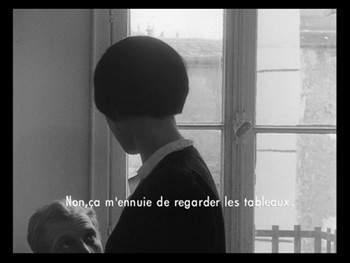

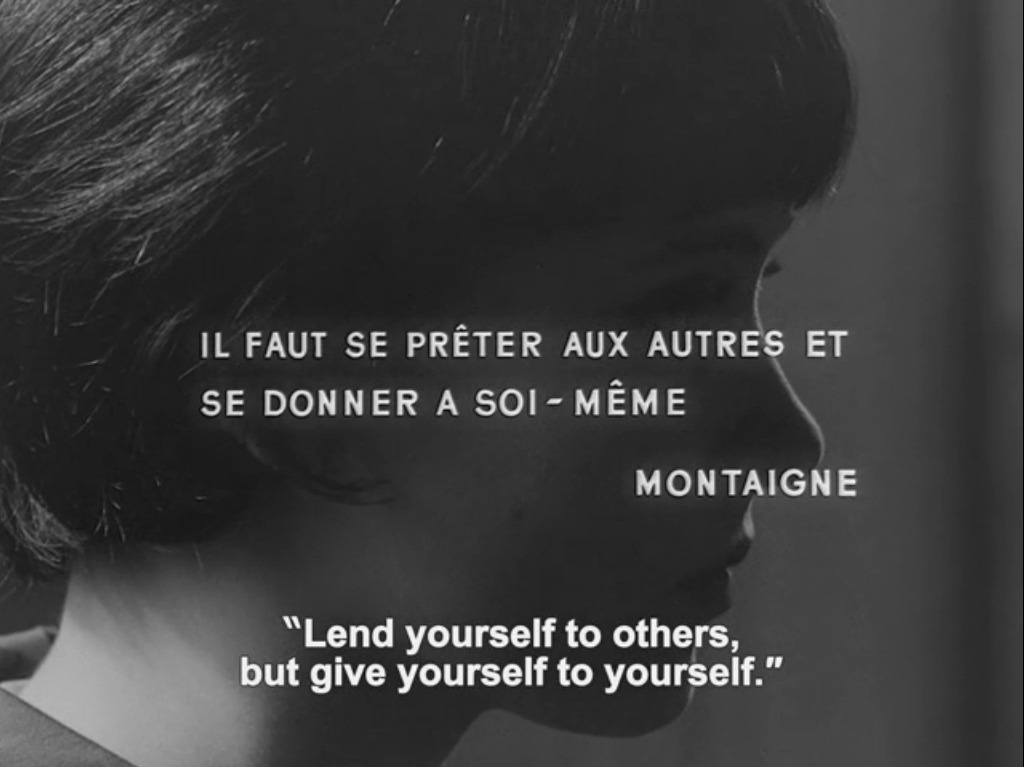









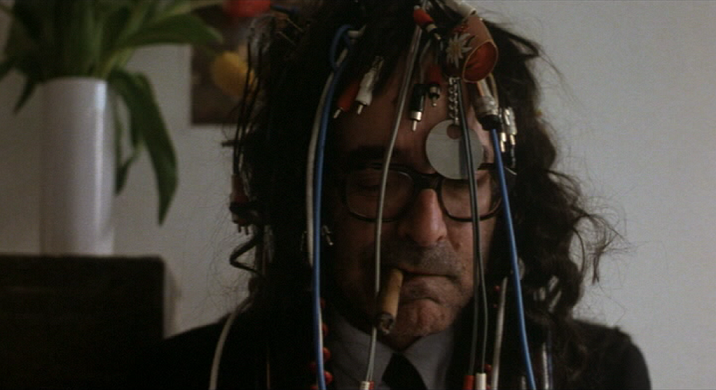

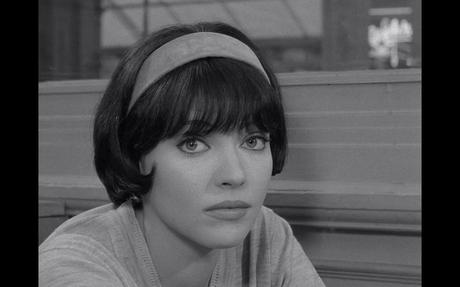






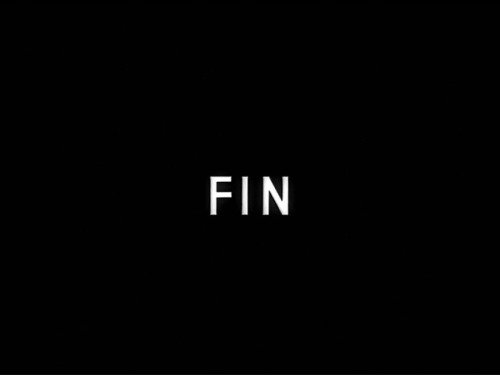
No comments:
Post a Comment